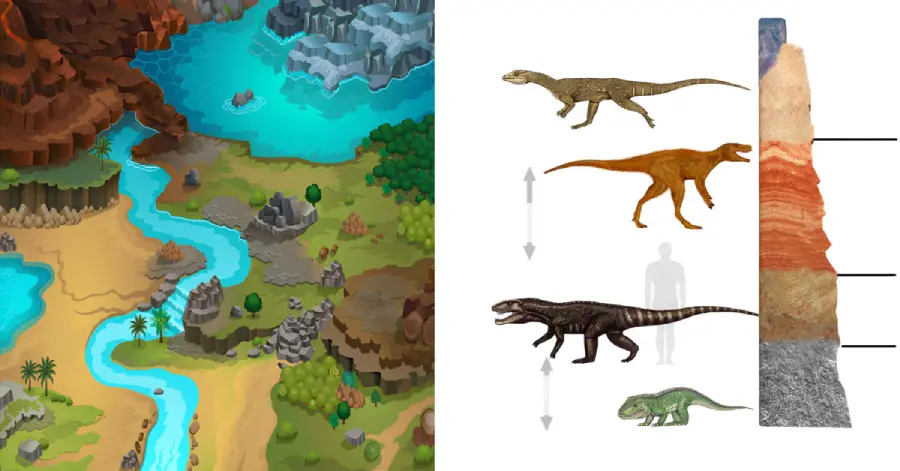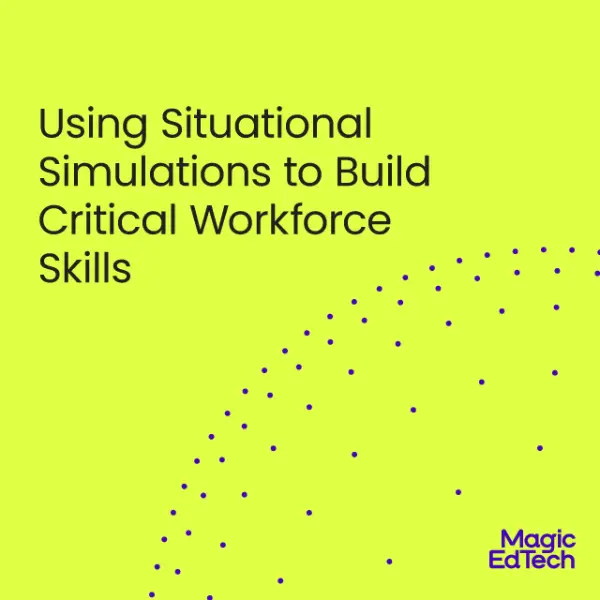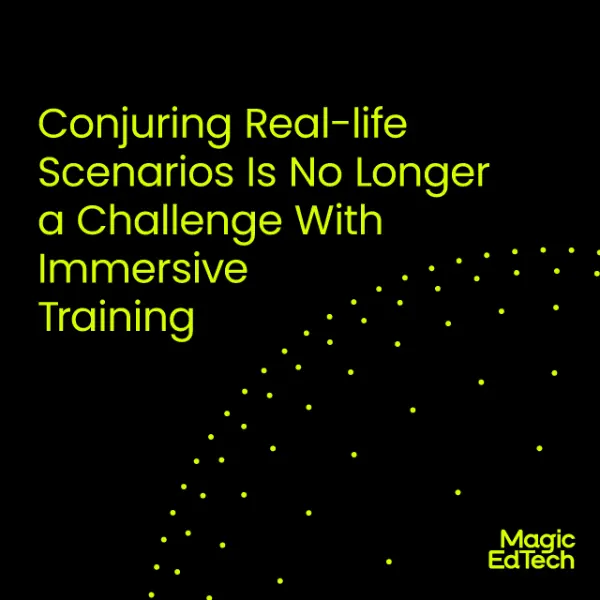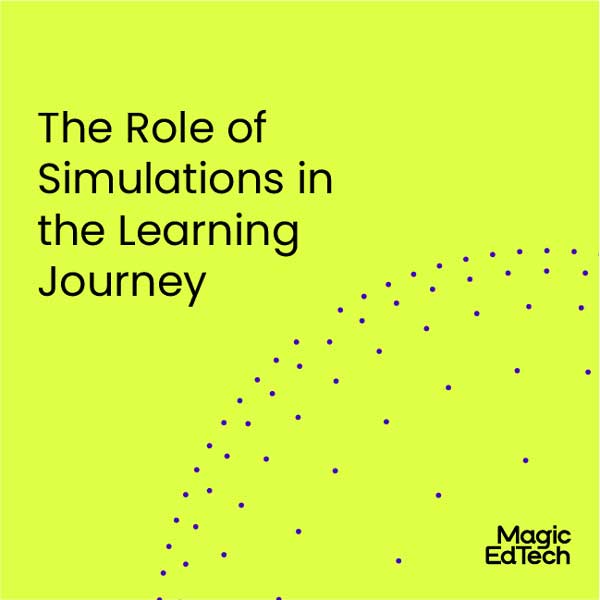An In-Depth Guide To Immersive Learning for Education and Corporate Training
- 18 March, 2024
- Reading Time: 22 mins
An Introduction to Immersive Learning
Immersive Learning Definition
Immersive learning is defined as an interactive and dynamic learning approach designed to deeply engage learners. It provides learners with experiential and practical learning opportunities to simplify concepts or give them hands-on knowledge. It uses emerging technologies to simulate real-world scenarios and environments, giving learners a safe, risk-free, or more exploratory approach to building skills and knowledge.
Immersive learning solutions can be integrated into K-12 products, schools, higher education, and professional training programs. Immersive learning experiences can be delivered in formats like Virtual Reality (VR), Augmented Reality (AR), Mixed Reality (MR), Simulations, or Games.
The Importance of Immersive Learning Solutions in the Digital Age
Immersive learning is crucial in the digital age due to its ability to address the growing demand for skilled workers and bridge the gap between theoretical knowledge and practical application.
Immersive learning platforms facilitate active participation by leveraging advanced technologies to simplify complex concepts and enhance memorization, thereby reducing the need for lengthy texts or documents. This not only makes learning more efficient but also boosts learner engagement.
Moreover, immersive learning experiences help learners understand the practical relevance of theoretical concepts by providing simulated real-world scenarios. This contextualization enables learners to grasp the significance of what they are learning and how it applies in practical situations.
Additionally, immersive learning encourages a deeper connection with the content by creating meaningful learning experiences that leave a lasting impact on learners. According to the experiential learning style theory by David Kolb, learners progress through four stages: concrete experience, reflective observation, abstract conceptualization, and active experimentation. Immersive learning facilitates this progression by providing concrete experiences and opportunities for reflection, leading to the development of new ideas that can be applied in real life.
In the latest WEF Future of Jobs Report, it was found that 44% of an individual worker’s skills will need to be updated. Business leaders either face skill shortages currently or expect them to increase in the upcoming years. To combat this issue, a training methodology that facilitates active skill development is essential, where learners engage actively in the learning process.
In essence, immersive learning enables learners to actively engage with the material, understand its practical implications, and internalize it at a deeper level, ultimately preparing them for success in the future.
The Significance of Immersive Learning in Education and Training
Immersive Learning Environments for K-12 and Higher Education
Student engagement is a more pressing concern than absenteeism. Studies indicate that students who are more engaged in academic activities, both in the classroom and beyond, are more likely to succeed in their careers. Educational institutions are constantly seeking new ways to engage learners and create lasting knowledge, and immersive learning is gaining traction as a way to engage learners and enhance learning outcomes even beyond the classroom.
In the classroom, immersive environments offer students the opportunity to learn by doing, engaging them in hands-on experiences that transcend the limitations of textbooks. Through these risk-free interactive simulations for exploration and practice, students can learn without fear of failure, fostering an environment conducive to learning. Whether delving into the intricacies of Romanian history or diving into the depths of the ocean, immersive learning captures students’ attention by activating multiple senses, leading to a deeper understanding and retention of knowledge. Game-based learning is always popular. It not only makes learning enjoyable but also facilitates experiential learning, where students can learn by failing and iterating until they succeed. Imagine the excitement of reliving historical events firsthand or the thrill of dissecting a virtual frog – these immersive learning experiences leave a lasting impression on students, making educational concepts more tangible and memorable.
Furthermore, immersive learning environments provide a realistic space for interaction. Students don’t just see; they can touch and manipulate virtual objects, solidifying information in their subconscious. This hands-on approach offers a better correlation with the subject matter. By narrowing the focus to specific tasks within the immersive environment, students can concentrate more effectively, leading to improved learning efficiency.
Immersive Learning versus Experiential Learning in Corporate Training
With a renewed corporate landscape, market trends demand a more dynamic training approach. Immersive learning benefits organizations from various industries, such as healthcare, automotive, retail, and more. By placing employees in simulated scenarios, it creates a realistic replication of their job roles. This allows employees to grasp key responsibilities, creating a better understanding than rote memorization.
Beyond theory, immersive learning environments provide a safe space for employees to learn from their mistakes. Traditional training often focuses on memorizing concepts, but immersive interfaces for engagement and learning allow for hands-on experience. Through diverse experiences like virtual reality, augmented reality, or mixed reality, employees can repeatedly practice, make mistakes, rectify them, and learn from the experience without real-world consequences. The simulated experiences allow learners to engage, diagnose, explore, and enable effective decision-making, all within a risk free environment.
Engagement is key to effective training, and immersive learning solutions are delivered through storytelling and gamification. By incorporating narratives and game-like elements, training becomes informative and tied to the experiences of employees. Storytelling helps employees focus and retain information, while gamification builds motivation, triggering their competitive instincts and making the learning process enjoyable and enriching.
The Types of Immersive Learning
Virtual Reality (VR) Programs
Virtual reality is a digitally simulated environment where people interact with 3D visuals and other virtually generated objects, leading to an immersive and sensory experience. This environment can be accessed through VR headsets, gloves, computer screens (non-immersive), VR lenses, bodysuits, motion-controlled equipment, and other interactive devices.
It creates a world that is distinct from reality. VR programs can serve various purposes including entertainment, education, training, simulation, and more. They often involve realistic simulations, interactive elements, and sometimes gamification to engage users and provide an immersive experience that feels like being physically present in a virtual world. For instance, you can be a part of virtual reality video games, which means instead of just playing, you’ll be able to interact with its characters, objects, and environment.
Though it might sound new, Virtual Reality traces its roots all the way back to the 1950s when Morton Heilig created the Sensorama, patented in 1962. It was an arcade-style theater cabinet designed to engage all senses, featuring stereo speakers, a stereoscopic 3D display, fans, smell generators, and a vibrating chair. In 1987, Jaron Lanier from VPL introduced the term “virtual reality,” giving a name to the field. His company also created groundbreaking gear like the Dataglove and EyePhone, pioneering VR technology and contributing to numerous products in the VR domain.
Applications of VR in Education
Immersive learning VR in education can redefine K-12 classrooms, vocational training, and other higher-ed studies. There are many use cases for VR in education, although it’s not applicable to every learning scenario. Let’s take a look at where VR programs for education are most effective.
Exploratory VR for Education
Virtual Reality modules can be designed for exploratory learning. Learners take a 360-degree leaning or in-depth field tour of museums, natural wonders, space, or pre-historic environments – places that may not be accessible to all in the real world. VR can also be used to explore alternate scenarios or future landscapes. For example, creating virtual simulations of ecosystems or environmental phenomena to study the impact of human activities on the environment.
VR for STEM and Biology
To make automobile engineering education more adaptable and aware of pragmatics, educational institutions are going for VR-based training to make our future engineers well-versed in real-world challenges. Human anatomy training deals with the functioning and basic structure of the human body. It also deals with the study of body components like cells, tissues, and membranes. With VR infused in anatomy, however, learners can view computer-generated anatomical body structures in high resolution with 3D visualization. Earlier, only established experts were able to interpret human anatomy through VR. However, with the evolution of immersive learning VR as a technology, students in medical labs are now able to have a detailed grasp of human anatomy.
VR to Build Critical Thinking Skills
Virtual reality scenarios offer opportunities to introduce students to complex ethical dilemmas, prompting them to navigate decisions and contemplate outcomes critically. Recent advancements in VR technology have enabled applications aimed at enhancing safety measures, addressing mental health concerns, and simulating emergency situations such as fire breakouts, or school shooter scenarios. The active shooter response training program deals with enhancing the circumstantial awareness amongst the students against the active shooting that happens in schools. To counter this, schools are teaching students to identify the early warning signs and follow a four-step emergency response technique- hide, escape, run, and overcome- while attacking is the last resort. Students can easily practice the entire technique in VR with a virtually generated shooter and protect themselves from the violent harm of shooting.
VR Training Simulations for Higher Ed and Workforce Skills
Medical professionals use VR simulations to provide students with immersive experiential learning, where they can practice on a computer-generated body and make trials and errors without risking human lives. Healthcare professionals, on the other hand, are using VR headsets and controllers to create haptic feedback for their students.
In VR for Professional Development, teachers are quite often given a classroom immediately after attaining their undergraduate degrees. However, they still have to learn about real-world practices in teaching. Here, immersive learning VR can come into play to help them gain practical experience in teaching. Through VR systems, these educators in a mixed reality setting can practice the lessons by interacting with student avatars, creating a classroom-like environment, and upskilling themselves. This also enables teachers to get a hold of students’ learning potential.
In this digital age, a good grasp of technology is a must; hence, technology is also a critical component of students’ academics. Thanks to VR, students can enhance their technological skills by curating digital creations and then witnessing them in a virtual environment. This enables them to learn about what all they have as a foundational skill and on what fronts they can improve.
VR Training Simulations for Corporate Learning
VR based training simulations emulate real-world scenarios that help employees learn through practice and hands-on experience. These kinds of simulations are used in domains where hands-on experience is extremely critical, like aviation, healthcare, and engineering.
Through VR training simulations, your team can practice complex tasks, handle unpredictable situations, make mistakes, rectify them, and assess the outcomes of their behaviors. This immersive experiential learning enables an employee to anticipate potential risks and consider apt methods to counter them.
Augmented Reality (AR)
Augmented reality is another type of immersive learning technology that overlays the real world with digitized content. It’s a combination of visuals, sound, and other sensorial elements that enhance and make the entire experience more engaging and interactive.
Unlike virtual reality, it doesn’t need a specific hardware to view it. You can use any smart device to view it in its full glory. AR is a system that includes three basic attributes – a merger of real and virtual worlds, real-time interactivities, and accurate representation of 3D virtual and real objects. It is one of the most easily available immersive interfaces for engagement and learning.
For instance, you can either scan a QR code or a marker image and learn about the historical significance of ancient elements, or you can direct the digital content in your smart device to the physical environment. You could also scan a picture of a cell and interact with the components using a mobile device.
With AR-based learning, students or even professionals can learn better by integrating multimedia support into it.
Enhancing Real-world Experiences
Augmented reality enhances the real-world experience with a seamless blend of audio-visual elements and attractive texts and reality.
AR also assists in problem-solving, streamlines complex tasks, and makes the real-world experience more interactive through 3D visuals and lifelike depiction.
With enhanced computing power and artificial intelligence baked into the AR. AR is on its way to eliminating the differences in both the digital and physical worlds.
Practical Applications
AR has a diverse use across applications. For instance, it’s used in primary schools and various higher-ed institutions where static images from textbooks to movable graphics. Immersive learning in education results in greater student retention and engagement.
AR is also used in fields that require practical hands-on, like medicine, aviation, and engineering.
AR is also used in shopping and fashion retail for a better customer experience and enables customers to customize the products or services they wish to purchase.
They can customize the design to how it should look in the real world. This spans from AR try-ons to viewing how it looks in real life without needing to go to the actual shop.
Digital experiences like AR and VR are enablers in increasing learner motivation, builds excitement, and helps in higher efficacy with the benefits of self-paced learning and repeatability.
Immersive Learning Benefits
Increased Engagement
Unlike traditional learning methods, immersive modules place learners in the heart of the action. These experiences trigger a powerful neurological response. As learners actively participate, make choices, and overcome challenges within the simulation, their brains strengthen existing neural pathways and create new ones. Immersive learning benefits learners by leveraging the brain’s remarkable ability to adapt and form new connections, known as neuroplasticity.
Moreover, immersive learning environments nurture a growth mindset by providing a safe space to experiment, make mistakes, and learn from them. This builds a sense of accomplishment and motivates learners to continue exploring and challenging themselves.
Enhanced Retention and Recall
Based on the “doing by learning” philosophy, immersive learning engages learners so deeply in the content resulting in more interconnected neural pathways that improve retention. While traditional approaches often rely on passive information intake, an immersive learning environment converts learners from spectators to active participants.
Immersive learning engages multiple senses – sight, sound, touch, and even kinesthetic input. This multisensory encoding creates a richer and more memorable learning experience. In the training world, immersive learning has some compelling use cases, with research demonstrating up to 4 times faster knowledge gain compared to traditional methods.
Self-Paced Learning & Repeatability
Immersive learning environments offer the advantage of repeatability, allowing learners to revisit complex concepts or scenarios multiple times until they fully grasp them. This repeated exposure helps reinforce learning and retention, leading to a deeper understanding of the subject matter.
Immersive learning also supports self-paced learning, where individuals can progress through the material at their own speed. This flexibility is particularly beneficial as it accommodates different learning styles and preferences. Learners can take the time they need to fully absorb the content without feeling rushed or left behind, promoting a more personalized and effective learning experience.
These aspects of immersive learning contribute significantly to its effectiveness in engaging learners and facilitating meaningful knowledge acquisition.
Real-world Application of Knowledge
An immersive learning platform converts education and training by creating realistic simulations of real-world scenarios, benefitting both students and the workforce by bridging the gap between theory and practical application.
Employees can practice product demonstrations and negotiation tactics with virtual clients, honing their communication skills and building confidence in their approach. Students can practice and prepare to work in a real work environment, developing critical decision-making abilities in a risk-free environment. The applications extend far beyond a single field.
By providing opportunities for safe, hands-on experience, immersive learning helps learners develop the practical skills and knowledge needed to thrive in real-world situations. This translates into a more confident and prepared workforce, better equipped to tackle challenges and excel in their respective fields.
Case Studies
Successful Implementations of Immersive Learning in Education
The Museum of the Future in Dubai is a unique museum that stimulates your senses. It has dedicated sections for children to explore categories such as space exploration, DNA preservation, AI robots, transportation, and more. They can learn all this through a wide range of simulations, videos, and exhibitions.
Cadaviz India’s first 3D virtual dissection table enables medical students, surgeons, doctors, and lab technicians to understand human anatomy clearly. With immersive 360-degree virtualization, medical students and professionals can rotate and zoom the body to map our blood vessels, nerves, and connections.
3D modeling allows individuals to observe organs from varied angles and focus on the cross-sections. This provides them with a complete grasp of physical anatomy, and they can also explore and uncover various layers of tissue and dissect them further.
Corporate Training Success Stories
IBM implemented immersive learning solutions in their corporate training in the form of virtual simulations. These virtual simulations enabled their salesforce to rehearse on-the-job scenarios, including negotiation with the clients and managing objections in a riskless environment. With these simulations baked into their training, IBM witnessed a 10% surge in the performance of their sales team.
Ernst & Young faced a training challenge with their auditors in identifying financial irregularities effectively. To fix this, they came up with forensic accounting simulations that created a replica of realistic scenarios where they had to unveil the fraudulent activities and report them. With this implementation, EY reported a significant increase in their financial fraud detection, leading to more accurate financial reporting for their clients.
Walmart introduced customer service simulations to their training programs for frontline employees, allowing them to practice attending to customer inquiries and resolving customer issues. This enhanced Walmart’s customer experience score and collectively boosted its employees’ morale.
Notable Examples from Various Industries
Delta Air Lines inculcated flight simulations replicating diverse weather conditions and emergencies. This resulted in a substantial decline in accidents and drastically improved pilot competency, as well as increased its reputation as a safe and secure airline.
Nestle Purina, a global leader in the pet food industry, created VR factory tours for their salespeople to give them a clear understanding of the production process and establish trust-based relationships with their clients. This saved Nestle USD 100K per year in travel and productivity.
Audi adopted a VR training approach for their packaging logistics, where employees virtually prepared the boxes, packed the items, and applied the labels by observing hand movements. This approach challenges their employees’ skills at every achievement level and significantly reduces costs and time.
Building Immersive Learning: Technical Challenges and Solutions
Challenge 1: Cost-effectiveness and Resource Allocation
Immersive learning presents significant challenges due to its relatively high development costs and the ongoing need to demonstrate its return on investment. The expenses associated with creating immersive modules include the development, implementation, acquisition, and maintenance of technology and infrastructure. Additionally, there are costs related to acquiring and maintaining hardware and devices. Moreover, expenses are incurred for training and developing administrators for these courses, as well as for maintaining and upgrading modules when necessary. With modern programming tools, interfaces, and frameworks, developers are able to build efficiencies over time and volume leading to a wider adoption of such immersive learning experiences across disciplines, institutions, and markets.
Strategies for addressing costs associated with immersive learning development
To address the challenge of cost-effectiveness and resource allocation in immersive learning development, organizations can conduct a thorough cost-benefit analysis to demonstrate its long-term value. Explore low-cost and scalable development tools like AI-based frameworks or pre-fabricated simulation modules to minimize the initial investment. It’s best to go with an immersive learning development partner with proven experience in delivering high-quality experiences at cost-effective prices. while prioritizing essential features can streamline costs. Higher ed or technical training institutions can seek collaborations with industry partners or seek external funding to develop these modules. Implementing a phased approach to development and focusing on high-impact areas first can further optimize resource allocation.
Challenge 2: Make Immersive Learning Accessible and Inclusive
The second most crucial challenge is the accessibility of these immersive learning modules. Within gamified learning, augmented reality (AR), virtual reality (VR), and simulated modules, certain components or segments may not cater to individuals with disabilities, including those with physical or cognitive impairments. Accessibility challenges extend to learners of various age groups, particularly older adults and young children, who may lack familiarity or comfort with next-generation software or hardware.
Building accessible and inclusive immersive learning environments
The most inclusive immersive modules prioritize accessibility from the get-go. Adhere to established guidelines like Universal Design for Learning (UDL) or WCAG to ensure that immersive modules are usable by individuals with diverse abilities. Conducting user testing with representative groups or persons with disabilities to identify and address accessibility barriers. Make accommodations for speech-to-text, voice-over, closed captions, and other assistive technologies within the module. You may also want to provide alternative modalities for content delivery to accommodate different learning preferences. Investing in lightweight and scalable technologies ensures compatibility with various devices and connectivity levels, enhancing accessibility for all learners. With the latest technological advancements, original equipment manufacturers (OEMs) have started to address these challenges by considering the integration of immersive hardware with assistive technologies. This approach aims to enable similar learning experiences for all types of learners, ensuring inclusivity and accessibility in the immersive learning landscape.
Challenge 3. Diluted Learning Objective
As immersive learning often relies on technology, there’s a risk of losing sight of the primary learning objectives. It’s crucial to strike a balance leveraging this emerging tech with what actually helps aid learning. Immersive learning experiences can often be overwhelming, making it difficult for learners to keep up with the pace. It can inundate learners with sensory stimuli, potentially leading to cognitive overload. When learners are overwhelmed by the complexity of the immersive experience, it can hinder their ability to process and retain information effectively. Therefore, it’s essential to have a well-thought-out learning design when creating highly immersive experiences. This design should prioritize the learning goals while ensuring that the immersive elements enhance rather than detract from the learning process.
Addressing Course Stickiness and Learning Goals
To keep the learning objective front and center, there must be a clear alignment between the experience modules and the learning goal. You need strong instructional design to incorporate scaffolding techniques and provide opportunities for reflection and instant feedback.
In the initial stages of the launch, there will be a need to track user feedback so that the modules can be iterated upon and improved for better learning outcomes. These days, immersive e-learning modules can also be integrated with analytics and assessments to track learner behavior and progress.
Challenge 4. Resistance to Change
It’s common to stumble into some resistance when trying to introduce emerging technology for learning. Many educators and learners are accustomed to traditional teaching and learning approaches, such as lectures and textbooks. They may resist immersive learning or be skeptical about the effectiveness of new technologies. The lack of experience or familiarity with immersive technologies may also be a contributing factor. Some learners may perceive these technologies as complex or intimidating. Educators and learners may question whether immersive experiences can truly enhance learning outcomes or if they are simply a novelty without substantial educational value.
Managing Resistance to Change
If the stakeholders and managers of your company are unsure of a program’s effectiveness, you need to present them with examples of case studies that were successful using this program.
You can also start with a pilot program by taking a few employees into account and asking them to monitor the entire process and results.
The employees working remotely face challenges related to content accessibility, not having the required equipment or proper software support, and weak internet connectivity. To solve this accessibility problem, your company must provide proper and on-time hardware and software support to remotely working employees.
Challenge 5. Authenticity and Quality
Creating high-quality immersive learning content necessitates a commitment to mirroring real-life situations with precision. Achieving this level of fidelity demands close collaboration between module designers and developers. Immersive learning content that lacks quality can feel artificial, potentially disconnecting learners from the experience. The authenticity of the content plays a crucial role in learner engagement and retention. When learners encounter scenarios that resonate with real-world experiences, their engagement deepens, and they are more likely to retain the knowledge imparted. ted. Therefore, partnering with an experienced immersive experience service provider who specializes in the design and development of high-quality modules can significantly enhance the authenticity and effectiveness of immersive learning experiences.
Apart from this, a company should also take into consideration employees with disabilities or diverse learning styles. The content should be designed with accessibility features baked into it. This helps you in ensuring that no one gets excluded from the learning experience.
Future Trends in Immersive Learning
Emerging Technologies
Immersive learning is growing rapidly for organizations with new and exciting opportunities in store with its new training programs. Here are a few of the latest examples:
AI Integration
With AI (Artificial Intelligence) being integrated into immersive learning solutions, learners can get greater personalized learning content with assessment tools as per their previous performance. In addition, AI companions (chatbots) are increasingly gaining popularity as learner aids within an immersive experience. This allows learners to enrich their learning experience and get the desired results straight out of training programs.
Advances in Hardware
With new hardware advancements in smart glasses and headsets, immersive learning is on the path to becoming more memorable in terms of learning experience.
For instance, remote assistance tools allow employees to collaborate with subject matter experts and on-the-job instructors easily.
Moreover, technological advancements like haptic gloves and bodysuits are taking VR training simulations a notch up. This enables the user to interact with certain tools, feel the virtual world and also opens the door for more memorable learning experiences.
Predictions for the Evolution of Immersive Learning
As of now, everyone thinks of immersive learning as a technological aid for developing hard skills. However, in the future, it’s expected that it could be used to nurture soft skills (communication, leadership, teamwork, etc.) too.
With the development of these diverse skills, employees can produce improved desired outcomes and offer better services to customers or clients.
Immersive interfaces for engagement and learning can ease employee upskilling since employees will be able to develop better hard and soft skills required for varied positions and the responsibilities they carry.
Implementing Immersive Learning Strategies
Steps for Integration in Educational Settings
- The first and foremost step to integrate immersive learning in education is to establish clear learning objectives and ensure that the module helps achieve the desired results and is in alignment to the relevant pedagogical standards.
- Combine different learning modes like lectures, podcasts, videos, or interactive activities to establish the main key concepts.
- The most realistic setting should be used when curating immersive learning experiences. For this, real-world situations, simulations, and environments should be the prerequisites for a successful learning experience.
- Integrate analytics, assessments, and instant feedback modules into your programs for adequate data collection, progress tracking, and meaningful analytics. Plan for adequate teacher training and support for after the learning product has been developed.
- Consult with industry experts or an immersive learning development expert to get the best out of your module.
Best Practices for Corporate Training
- The primary step in setting up any new corporate training program is to ensure that your employees know that immersive learning technologies are a boon to them and that they don’t have to fear the inculcation of new technologies. The key objectives of introducing immersive learning at the workplace, how it will lead to the success of the organization and the measurement metrics should be clearly laid out.
- After laying out the basic rock bed of immersive training, you need to identify its use cases and how it can be rolled out and adopted. For that, you need to have a proper rollout plan in action and the apt amount of organizational data required to assess the impact of immersive training.
- To roll out immersive learning in your organization, you should also have adequate data regarding the stakeholders for whom the training area is crucial. By facilitating required training deployments, you will be able to streamline the process of rolling out this training to a majority of your employees at an organizational scale.
DIY Immersive Learning for Individuals
Immersive learning doesn’t always need to have tech alongside it. Any immersive learning module should have engaging learning methods that create a fun and playful learning environment. Immersive learning isn’t just restricted to attractive classrooms or corporate offices but can also be of great value to individuals as well. Here are a few steps that can enhance your immersive learning experience at home:
- You can role-play with your family or friends. It could be prepping a job interview, deal negotiation, or delivering a presentation. This gets you ready for the probable questions that could be asked and reflects your positives and weaknesses as per your performance.
- Create your own trivia games through flashcards, escape rooms, or puzzles that cover the topic you wish to learn.
- You can now discover various museums, historical sites, and natural architecture in the comfort of your home through just a small VR headset, and that too in 360-degree. You can get a virtual tour through free videos available on video streaming platforms like YouTube.
- Choose the podcasts or audiobooks on the subject matter you wish to learn. You can have a listen while working out at the gym while jogging, or while just cooking your favorite dish.
- If you wish to learn about a certain subject matter or learn a specific skill set, just for digital simulations and games available online that give you practice and learn in a more hands-on manner, and that too at your own learning pace.
Encouragement for Readers to Explore and Implement
As immersive learning gels with modern-day technologies, it’s emerging day by day and will come with something new. With changing times, its adoption rate has gone significantly up and is expected to continue to ease up the overall learning process and give a sharp surge to lifelong learning.
For more information regarding how immersive learning is changing the workplace training landscape, head to our blog on- Conjuring Real-life Scenarios Is No Longer a Challenge With Immersive Training.









